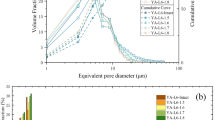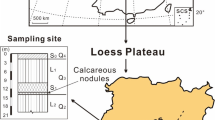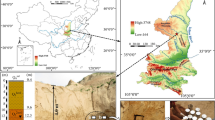Abstract
As the macroscopic mechanical properties of soil are closely related to its microstructure, and loess historically played an important role in engineering construction, the effect of compaction on the microstructure of compacted loess was investigated using scanning electron microscopy (SEM) and mercury intrusion porosimetry (MIP) in this study. The SEM imaging results showed that as compaction degree increased, the loess microstructure evolved from an overhead weak into an interlocking semi-cementation, and then into a dispersion-strong cementation. Correspondingly, the pore characteristics mainly exhibited a transformation from macropores (diameter > 32 μm) to mesopores (diameter between 8 and 32 μm) and then to small pores (diameter between 2 and 8 μm). The MIP test results showed that the content volume of intragranular pores (diameter between 1.8 and 70 μm) decreased with increasing loess compactness, whereas the contents of intra-particle, interparticle, and intergranular pores were stable, indicating that the compaction of loess was mainly caused by compression of the intragranular pores. Additionally, the variation interval of the dominant pore type (intragranular pore) observed by the MIP test was consistent with the comprehensive variation interval of the pore types (macropore, mesopore, and small pores) observed by SEM imagery. These findings are helpful to explain the linkage law between loess structure, engineering characteristics, and catastrophic effects.













Similar content being viewed by others
References
Alabi O (2011) Validity of Darcy’s law in laminar regime. Electron J Geotech Eng 16:27–40
Ali A, Biggs AJW, Marchuk A, Bennett JM (2019) Effect of irrigation water pH on saturated hydraulic conductivity and electrokinetic properties of acidic, neutral, and alkaline soils. Soil Sci Soc Am J 83(6):1672–1682
Al-Taie L, Pusch R, Knutsson S (2014) Hydraulic properties of smectite rich claycontrolled by hydraulic gradients and filter types. Appl Clay Sci 87:73–80
Assadi-Langroudi A, Ng’ambi S, Smalley I (2018) Loess as a collapsible soil: some basic particle packing aspects. Quatern Int 469:20–29
Assallay AM, Rogers CDF, Smalley IJ (1996) Engineering properties of loess in Libya. J Arid Environ 32(4):373–386
ASTM (2006) Annual book of ASTM standards. ASTM International, West Conshohocken, Pa
Bourazanis G, Katsileros A, Kosmas C, Kerkides P (2016) The effect of treated municipal wastewater and fresh water on saturated hydraulic conductivity of a clay-loamy soil. Water Resour Manag 30(8):2867–2880
Cheng Q, Tang CS, Xu D, Zeng H, Shi B (2021) Water infiltration in a cracked soil considering effect of drying-wetting cycles. J Hydrol 593:125640
Daniel DE (1994). In: Daniel DE, Trautwein SJ (eds) State-of-the-art: laboratory hydraulic conductivity tests for saturated soils. ASTM International, West Conshohocken, PA, pp 30–78
Delage P, Lefebvre G (1984) Study of the structure of a sensitive Champlain clay and of its evolution during consolidation. Can Geotech J 21(1):21–35
Derbyshire E (2001) Geological hazards in loess terrain, with particular reference to the loess regions of China. Earth Sci Rev 54(1):231–260
Ge MM, Pineda JA, Sheng DC, Burton GJ, Li N (2021) Microstructural effects on the wetting-induced collapse in compacted loess. Comput Geotech 138:104359
Giesche H (2006) Mercury porosimetry: a general (practical) overview. Part Part Syst Charact 23(1):9–19
Hou K, Qian H, Zhang YT, Zhang QY, Qu WG (2021) New insights into loess formation on the southern margin of the Chinese Loess Plateau. CATENA 204:105444
Hansbo S (2001) Consolidation equation valid for both Darcian and non-Darcian flow. Geotechnique 51:51–54
Jiang M, Zhang F, Hu H, Cui Y, Peng J (2014) Structural characterization of natural loess and remolded loess under triaxial tests. Eng Geol 181:249–260
Jozefaciuk G, Czachor H, Lamorski K, Hajnos M, Swieboda R, Franus W (2015) Effect of humic acids, sesquioxides and silica on the pore system of silt aggregates measured by water vapour desorption, mercury intrusion and microtomography. Eur J Soil Sci 66(6):992–1001
Kloubek J (1981) Hysteresis in porosimetry. Powder Technol 29(1):63–73
Lee KT, Ho JY (2009) Prediction of landslide occurrence based on slope-instability analysis and hydrological model simulation. J Hydrol 375(3–4):489–497
Lei XY (1987) The types of loess pores in China and their relationship with collapsibility. Sci China B 17(12):1309–1318 (in Chinese)
Li G, Wang F, Ma W, Fortier R, Mu Y, Mao Y, Hou X (2018) Variations in strength and deformation of compacted loess exposed to wetting-drying and freeze-thaw cycles. Cold Reg Sci Technol 151:159–167
Li P, Qian H, Wu J (2014) Environment: accelerate research on land creation. Nature 510(7503):29–31
Li P, Vanapalli S, Li T (2016) Review of collapse triggering mechanism of collapsible soils due to wetting. J Rock Mech Geotech Eng 8(2):256–274
Li PF, Sun Q, Geng JS, Yan XS, Tang LY (2022) Radon exhalation from temperature treated loess. Sci Total Environ 832:154925
Li X-A, Li L, Song Y, Hong B, Wang L, Sun J (2019) Characterization of the mechanisms underlying loess collapsibility for land-creation project in Shaanxi Province, China–a study from a micro perspective. Eng Geol 249:77–88
Li XA, Li LC (2017) Quantification of the pore structures of Malan loess and the effects on loess permeability and environmental significance, Shaanxi Province, China: an experimental study. Environ Earth Sci 76(15):523
Li Y (2018) A review of shear and tensile strengths of the Malan loess in China. Eng Geol 236:4–10
Lu Y, Liu SH, Zhang YG, Wang LJ, Li Z (2021) Hydraulic conductivity of gravelly soils with various coarse particle contents subjected to freeze-thaw cycles. J Hydrol 598:126302
Liu Z, Liu F, Ma F, Wang M, Bai X, Zheng Y, Yin H, Zhang G (2015) Collapsibility, composition, and microstructure of loess in China. Can Geotech J 53(4):673–686
Luo H, Wu F, Chang J, Xu J (2018) Microstructural constraints on geotechnical properties of Malan loess: a case study from Zhaojiaan landslide in Shaanxi province, China. Eng Geol 236:60–69
Ma Y (2017) Multiscale research of loess structural behavior. Northwest University, Xi’an (Doctor Thesis)
Monroy R, Zdravkovic L, Ridley AJG (2010) Microstructural evolution in compacted London clay during wetting and loading. Géotechnique 60(2):105–119
Munoz-Castelblanco JA, Pereira JM, Delage P, Cui YI (2012) The water retention properties of a natural unsaturated loess from northern France. Geotechnique 62(2):95–106
Nan JJ, Peng JB, Zhu FJ, Zhao JY, Leng YQ (2021) Multiscale characteristics of the wetting deformation of Malan loess in the Yan’an area, China. J Mt Sci 18(4):1112–1130
Ng CWW, Sadeghi H, Hossen SKB, Chiu CF, Alonso EE, Baghbanrezvan S (2016) Water retention and volumetric characteristics of intact and re-compacted loess. Can Geotech J 53(8):1258–1269
Pécsi M (1990) Loess is not just the accumulation of dust. Quatern Int 7–8:1–21
Qi S, Vanapalli SK (2015) Hydro-mechanical coupling effect on surficial layer stability of unsaturated expansive soil slopes. Comput Geotech 70:68–82
Rabot E, Wiesmeier M, Schlüter S, Vogel H-J (2018) Soil structure as an indicator of soil functions: a review. Geoderma 314:122–137
Romero E (2013) A microstructural insight into compacted clayey soils and their hydraulic properties. Eng Geol 165:3–19
Shear DL, Olsen HW, Nelson KR (1992) Effects of desiccation on the hydraulic conductivity versus void ratio relationship for a natural clay. Transportation Research Board, USA
SGTM (2019) Standard for geotechnical testing method (GB/T 50123–2019), National standards of People’s Republic of China. China Planning Press, Beijing
USDA (1951) Soil Survey Manual, U.S. Department of Agriculture (USDA) Agricultural Handbook No. 18. U.S. Government Printing Office, Washington, DC
Wang H, Qian H, Gao Y (2020a) Non-Darcian flow in loess at low hydraulic gradient. Eng Geol 267:105483
Wang J-D, Li P, Ma Y, Vanapalli SK (2019) Evolution of pore-size distribution of intact loess and remolded loess due to consolidation. J Soils Sediments 19(3):1226–1238
Wang J-J, Qiu Z-F (2017) Anisotropic hydraulic conductivity and critical hydraulic gradient of a crushed sandstone–mudstone particle mixture. Mar Georesour Geotechnol 35(1):89–97
Wang JD, Li P, Ma Y, Vanapalli SK, Wang XG (2020b) Change in pore-size distribution of collapsible loess due to loading and inundating. Acta Geotech 15(5):1081–1094
Wang TM, Wu JG, Kou XJ, Oliver C, Mou P, Ge JP (2010) Ecologically asynchronous agricultural practice erodes sustainability of the Loess Plateau of China. Ecol Appl 20(4):1126–1135
Washburn EW (1921) Note on a method of determining the distribution of pore sizes in a porous material. Proc Natl Acad Sci USA 7(4):115
Wu FC, Liu Y, Zhao XN, Guo ZT et al (2021) Research report on progress strategy of environmental science disciplines. Science Press, Beijing
Xie W-L, Li P, Zhang M-S, Cheng T-E, Wang Y (2018) Collapse behavior and microstructural evolution of loess soils from the Loess Plateau of China. J Mt Sci 15(8):1642–1657
Xu J, Lan W, Li YF, Wang SH, Cheng WC, Yao XL (2020a) Heat, water and solute transfer in saline loess under uniaxial freezing condition. Comput Geotech 118:103319
Xu P, Lin T, Qian H, Zhang Q (2021a) Anisotropic microstructure of loess-paleosol sequence and its significance for engineering and paleoclimate: a case study from Xiushidu (XSD) profile, southern Chinese Loess Plateau. Eng Geol 286:106092
Xu P, Zhang Q, Qian H, Hou K (2020b) Investigation into microscopic mechanisms of anisotropic saturated permeability of undisturbed Q2 loess. Environ Earth Sci 79(18):412
Xu PP, Qian H, Zhang QY, Zheng L (2021b) Exploring the saturated permeability of remolded loess under inorganic salt solution seepage. Eng Geol 294:106354
Xu PP, Zhang QY, Qian H, Li MN, Yang FX (2021c) An investigation into the relationship between saturated permeability and microstructure of remolded loess: A case study from Chinese Loess Plateau. Geoderma 382:15
Xu PP, Zhang QY, Qian H, Qu WG, Li MN (2021d) Microstructure and permeability evolution of remolded loess with different dry densities under saturated seepage. Eng Geol 282:14
Xu PP, Zhang QY, Qian H, Yang FX, Zheng L (2021e) Investigating the mechanism of pH effect on saturated permeability of remolded loess. Eng Geol 284:105978
Xu P (2021) Study on water-soil interaction mechanism of permeability change of remolded loess. Chang’an University, Xi’an, China (D.S. Thesis)
Xu PP, Qian H, Zhang QY, Li WQ, Ren WH (2022a) Investigating saturated hydraulic conductivity of remolded loess subjected to CaCl2 solution of varying concentrations. J Hydrol 612:128135
Xu PP, Qian H, Zhang QY, Shang JT, Guo YK, Li MN (2022b) Response mechanism of permeability change of remolded loess to seepage parameters. J Hydrol 612:128224
Yan X, Duan Z, Sun Q (2021) Influences of water and salt contents on the thermal conductivity of loess. Environ Earth Sci 80(2):1–14
Zhang T, Ma L, Zhang R, Wang Q, Li J (2019) Analysis for effect of MIP-Based compaction on microstructure of remolded mud stone with “micro-expansion.” J Eng Geol 27(04):717–722 (in Chinese)
Zhang X, Lu T, Lu Y, Lu Y, Li X, Pan W (2018) Characteristics of Malan loess porosity in south Jingyang plateau under scanning electron microscope. Bull Soil Water Conserv 38(03):212–216 (in Chinese)
Zhang X, Qian H, Wu H, Chen J, Qiao L (2016) Multivariate analysis of confined groundwater hydrochemistry of a long-exploited sedimentary basin in Northwest China. J Chem 2016:1–15
Zhang Y, Bing H, Yang CS (2015) Influences of freeze-thaw cycles on mechanical properties of silty clay based on SEM and MIP test. Chin J Rock Mech Eng 34(S1):3597–3603
Zhang Y, Cao W, Wang W, Dong Q (2013) Distribution of groundwater arsenic and hydraulic gradient along the shallow groundwater flow-path in Hetao Plain, northern China. J Geochem Explor 135:31–39
Acknowledgements
The authors would like to thank all the reviewers who participated in the review and MJ Editor (www.mjeditor.com) for its linguistic assistance during the preparation of this manuscript.
Funding
The present work was supported by the National Natural Science Foundation of China (Grant Nos. 42202311, 41931285, 42007184, and 41790441), the China Postdoctoral Science Foundation (Grant No. 2022M710480), the Fundamental Research Funds for the Central Universities, CHD (Grant No. 300102292901), the Programme of Introducing Talents of Discipline to Universities (Grant No. B08039), and the Innovation and Entrepreneurship Training Program for College Students (Grant No. S202210710364). Their support is gratefully acknowledged.
Author information
Authors and Affiliations
Corresponding author
Rights and permissions
Springer Nature or its licensor (e.g. a society or other partner) holds exclusive rights to this article under a publishing agreement with the author(s) or other rightsholder(s); author self-archiving of the accepted manuscript version of this article is solely governed by the terms of such publishing agreement and applicable law.
About this article
Cite this article
Xu, P., Qian, H., Chen, J. et al. New insights into microstructure evolution mechanism of compacted loess and its engineering implications. Bull Eng Geol Environ 82, 36 (2023). https://doi.org/10.1007/s10064-022-03058-3
Received:
Accepted:
Published:
DOI: https://doi.org/10.1007/s10064-022-03058-3




